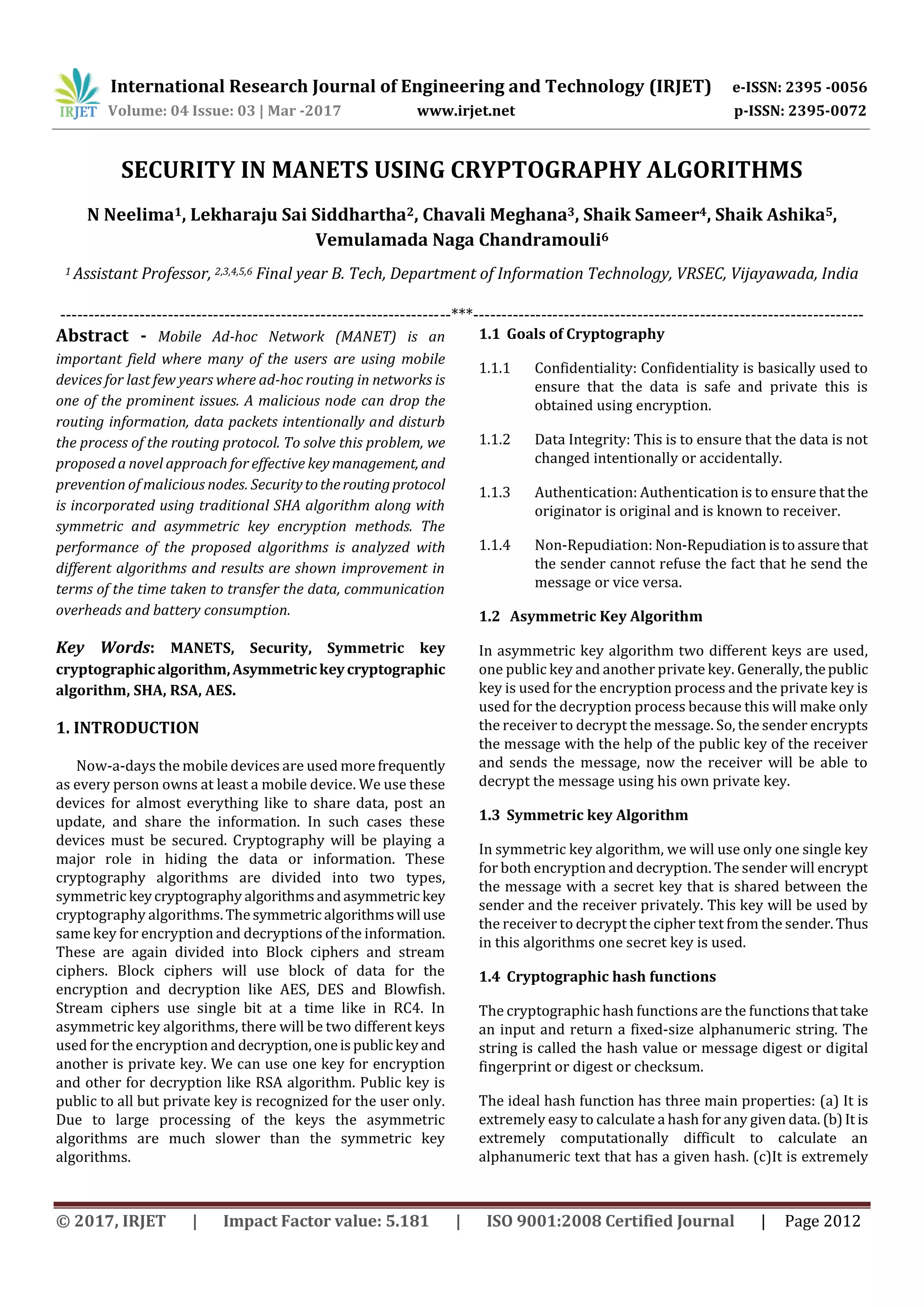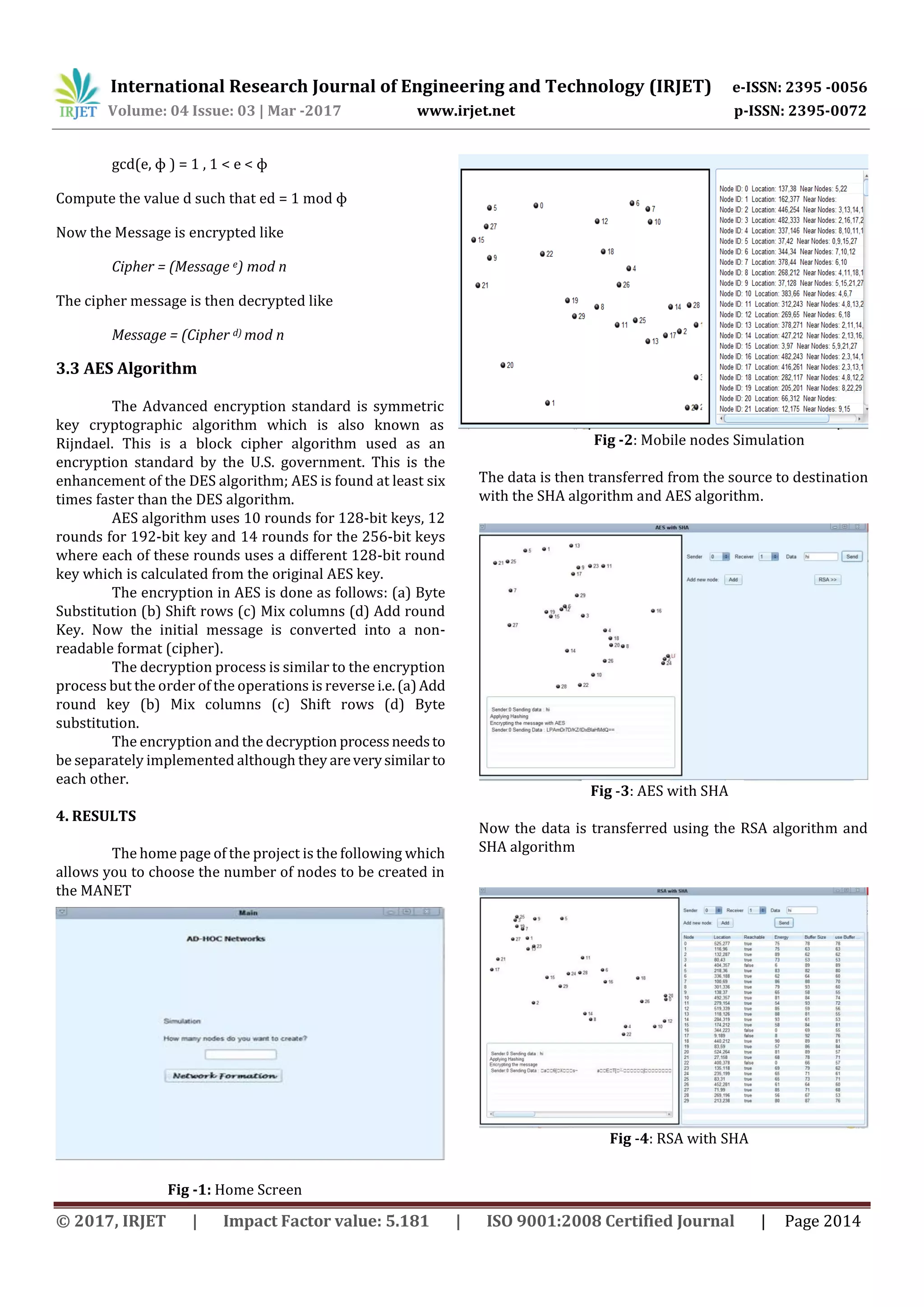This document discusses security in mobile ad hoc networks (MANETs) using cryptography algorithms. It proposes a novel approach for effective key management and prevention of malicious nodes in MANETs. The approach incorporates security to the routing protocol using traditional SHA algorithm along with symmetric (AES) and asymmetric (RSA) key encryption methods. It analyzes the performance of the proposed algorithms by comparing the time taken to transfer data, communication overheads, and battery consumption. The results show that using AES with SHA provides better performance than using RSA with SHA, as RSA consumption more time and battery due to its large prime number calculations and operations.

![International Research Journal of Engineering and Technology (IRJET) e-ISSN: 2395 -0056 Volume: 04 Issue: 03 | Mar -2017 www.irjet.net p-ISSN: 2395-0072 © 2017, IRJET | Impact Factor value: 5.181 | ISO 9001:2008 Certified Journal | Page 2013 unlikely that two slightly different messages will have the same hash. A cryptographic hash function should behave as much as possible like a random function while still being efficiently computable. A cryptographic hash function is considered "insecure" from a cryptographic point of view,ifeitherofthe following is computationally feasible, finding a (previously unseen) message that matches a given hash values and finding "collisions", in which two different messages have the same hash value. 2. LITERATURE SURVEY In [1] it is concluded that AES is faster and more efficient than other encryption algorithms. When the broadcast of data is considered there is insignificant difference in performance of different symmetric key schemes. Under the scenario of data transfer it would be better to use AES scheme in case the encrypted data is stored at the other end and decrypted multiple times. In 2016, Madumita Panda hasdoneperformanceanalysisof encryption algorithms for security. In this paper, the professor compared different algorithms in terms of CPU time, memory, the algorithms include symmetric as well as asymmetric algorithms. In 2014, Suni kumar Sahu, Ajay kushwaha have done analysis of symmetric encryption algorithms for mobile ad hoc network. In this paper, he compared onlysymmetrickey algorithms in the MANETS anddisplayedtheresultsinterms of battery usage, end to end delay, processing time etc. The author used ns2 simulator to compare the performance of the algorithms. In 2016, M V Narayana, Dr G Narsimha, Dr SSVN Sarma proposed security enhancement in MANETS using SHA Algorithm [6]. In this paper, the authors proposed a method to improve the security in the mobile ad hoc networks using the Secure Hashing Algorithm. In [2] it states that AES is faster and more proficient than other encryption algorithms. Increasing the key size by 64 bits of AES leads to increase in energy consumption about8%without any data transfer. The difference is not obvious. Reducing the number of rounds leads to power savings but it makes the protocol insecure for AES and should be avoided. 3. PROPOSED SYSTEM The proposed system involves a multi-level security in MANETS where the data is will undergo the cryptographic hash function and an encryption algorithm and is sent to the destination where the data is decrypted and the data is checked for its integrity using the SHA algorithm. At the sender the message digest of the data that has to be sent is obtained using the SHA-256 algorithm, then the data along with the message digest is encrypted and will be transmitted to the destination. Whenthemessageisreceived at the destination it will be decrypted and the hash code value of the incoming message is compared to the value that is concatenated to the input string. This way the integrity of the message is verified. Now AES algorithm and RSA algorithmsareusedintheplace of the encryption algorithms and their performance is compared. 3.1 SHA-256: SHA-256 belongs to the SHA-2 family of hash functions; the family consists of SHA-256 and SHA-512 that are differentiated by the word block sizes. The FIPS PUB 180-2 standard is followed by the SHA-256. This is developed by the National Institutes of Standards and Technology (NIST) and other government and private parties. A hash function is a mathematical function that converts the input valued into another compressed value of fixed length. The input to the hash function is of arbitrary length but output is of fixed length. SHA-256 operates in the manner of MD4, MD5 and SHA-1. The message is first padded with itslengthinsucha waythat the result is a multiple of 512 bit long word then it is parsed into 512-bit message blocks M1, M2 … Mn. Now theblocksare processed one at a time beginning from the initial buffer H (0), sequentially calculate H(i) = H(i-1) + CMi *( H(i-1) ) Where C is the SHA-256 compression function and + means word-wise mode 232 addition. H(n) is the hash or message digest of the message 3.2 RSA Algorithm RSA is the acronym derived for Ron Rivest, Adi Shamir and Leonard Adleman, who first described it in 1978. This algorithm is used to encrypt and decrypt the messages. It is an asymmetric cryptographic algorithm means it uses two different keys for encryption and decryption. The main steps in the RSA algorithm are (a) Key Generation (b) Encryption (c) Decryption. The key generation can be done as follows: Generate two large prime numbers p and q of approximately equal size. Find the product of the two numbers let it be ‘n’. n = p*q Calculate ɸ such that ɸ = (p-1)*(q-1). Next choose ‘e’ such that](https://image.slidesharecdn.com/irjet-v4i3535-180104083232/75/Security-in-Manets-using-Cryptography-Algorithms-2-2048.jpg)

![International Research Journal of Engineering and Technology (IRJET) e-ISSN: 2395 -0056 Volume: 04 Issue: 03 | Mar -2017 www.irjet.net p-ISSN: 2395-0072 © 2017, IRJET | Impact Factor value: 5.181 | ISO 9001:2008 Certified Journal | Page 2015 Finally the time and the battery consumptions of both the techniques are compared and the results are shown below: Fig -5: Time comparisons for AES with SHA and RSA with SHA (in seconds) Fig -6: Battery comparisons for AES with SHA and RSA with SHA 5. CONCLUSIONS AND FUTURE WORK The RSA algorithm will consume more time because of the large processing of the information. This makes the AES algorithm faster that the RSA algorithm. The battery consumption factor is also high for the RSA algorithm because of the calculation of the largeprimesandoperations on them. This leaves that the AES along with the SHA shows better results than the RSA along with the SHA. In future these algorithms will become obsolete as the advancement of the mobile processing technology and the introduction of highly advanced processing machines like super computers and quantum computers. Sothesecurity in these MANETS are to be provided by the future proof algorithms rather than algorithms that are vulnerable to brute force attacks in the future. REFERENCES [1] Nagesh Kumar, Jawahar Thakur, Arvind Kalia on “Performance Analysis Of Symmetric Key Cryptography Algorithms: DES, AESAndBlowfish―inAnInternational Journal of Engineering Sciences ISSN: 22296913 Issue Sept 2011, Vol.4, pp.28-37. [2] S.Hirani, ''Energy Consumption of Encryption Schemes in Wireless Devices Thesis,'' university of Pittsburgh, April 9, 2003. Retrieved October 1, 2008, at: portal.acm.org/ citation.cfm?id=383768. [3] Tamimi, A Al; ―Performance Analysis of Data Encryption Algorithms‖, Oct 2008. [4] Nadeem, Aamer; "A Performance Comparison of Data Encryption Algorithms", IEEE 2005. [5] Ruangchaijatupon, P. Krishnamurthy,‟ Encryption and Power Consumption in Wireless LANs-N,‟‟ The Third IEEE Workshop on Wireless LANs -September 27-28, 2001- Newton, Massachusetts. [6] M V Narayana, Dr G Narsimha,DrSSVN Sarma proposed “Security enchancement in MANETS using SHA Algorithm”, 2016. [7] W. Stallings. “Cryptography and Network Security”: Principlesand Practice. Prentice Hall, 2nd edition, 1999.](https://image.slidesharecdn.com/irjet-v4i3535-180104083232/75/Security-in-Manets-using-Cryptography-Algorithms-4-2048.jpg)